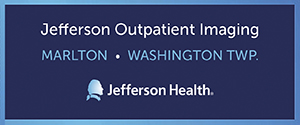
Answering the Call
Contact tracing is key to helping prevent the spread of coronavirus, but there’s been some challenges along the way.
Contact tracing—two words we’ve heard more the past few months than most of us in our lifetime. According to state and local health officials, contact tracing is essential to stopping the spread of the coronavirus. It’s also a hot topic here in South Jersey and worldwide.
New Jersey has taken major steps with its contact tracing program for COVID-19 and local health officials and contact tracers have worked tirelessly to help stop the spread of the coronavirus. We talked to these officials to get more information on the program, the impact it’s making and the bumps they have encountered.
What is Contact Tracing?
Contact tracing is identifying people who have an infectious disease—in this case, COVID-19—and people they came in contact with. The goal is to reduce the virus from spreading.
For example, if someone tested positive for the coronavirus, contact tracers reach out to that person and ask them where they think they contracted the virus, were they at a large gathering and who and how many people they were with. Once they find out who they were with, the contact tracers reach out to those people as well to let them know they may have been exposed and to take necessary precautions.
“What you want to do is get on top of the spread so as few people as possible are exposed to it,” says Herbert Conaway, director, Burlington County Health Department. “By doing that, by advising people to self-isolate and take other precautions like hand-washing and staying out of work, you can keep the disease from spreading further and if the virus can’t move from one person to another, you can stop the virus from spreading. This is why it’s so critical.”
Last month, New Jersey started the Community Contact Tracing Corps, a program where the Rutgers School of Public Health developed curriculum—an 18-hour online training.
As of press time, the state has hired 1,344 contact tracers who were trained by the Rutgers School of Public Health. These contact tracers are a mix of graduate students and local health department officials from around the state who were deployed by the New Jersey State Department of Health; 638 were hired from the Rutgers School of Public Health.
According to the New Jersey Department of Health, data provided by the state for the week ending Aug. 1 shows 45 percent of people refused to provide contacts of those who were exposed to the coronavirus.
“It’s an alarming number,” Conaway says. “The virus knows no partying, no race, no sex and doesn’t care if you have a chronic illness or if you are 2 years old. If it’s on your body, it’s most likely jumping to another body, and the only way we get on top of this depends on the human response. If we don’t get on top of it through contact tracing, what we get are big outbreaks and a resurgence of the disease. I can’t emphasize enough asking people to comply. Wouldn’t you want to take steps to protect your neighbor or family members from this disease? Don’t you want to know how to manage it?”
In an effort to have more people answer calls from contact tracers, the state recently launched a Contact Tracing Dashboard. This dashboard will be updated weekly with information such as the percentage of the cases successfully interviewed, those who provided contacts, contacts that were notified and more.
“Our new Contact Tracing Dashboard will allow the public to monitor progress of our contact tracing efforts,” Gov. Phil Murphy said in a press release. “It is critical for all New Jerseyans to answer contact tracing calls in order to stop the spread of COVID-19. This dashboard will join several other public-facing platforms that we have created for the purposes of transparency and public awareness.”
Comforting Call
A Cherry Hill resident who asked not to be named received a call from a contact tracer at her local health department in regard to her son’s positive test. Once they explained their reason for their call, she was happy to speak with them and to provide any information she was able to at the time.
“That’s the only way it could work,” she says. “If I’m going to refuse to give her any information, how can they do their job which is to ultimately help us?”
A few days after Diane Humphreys and her boyfriend’s COVID test came back positive, they received a phone call. The number came up as spam so she didn’t answer it, but they left a voicemail identifying themselves from the Burlington County Board of Health which prompted her to call back.
“They asked all the usual suspect questions—where were we last, when did my symptoms start, how many people are in the house, are there any children, do we work in the house/out of the house, and where we may have traveled,” the Marlton resident recalls.
Humprehys says she felt comfortable answering the health department’s questions, especially if this information could help someone, but she discovered something else while talking with the contact tracers.
“I have to say, their phone calls have been the most comforting part of this journey,” she says. “The time on the phone was valuable and we would have talked all day to these people if we could. There was no rush, they were very pleasant, professional and there was a human aspect to it. It wasn’t robotic or clinical, they spoke to you like you mattered. … They are a great support system and encouraged [us] to call back if we had any other questions.”
A Common Practice
According to Conaway, contact tracing is a “common and age-old public health practice” that has been taking place long before COVID-19.
“It is a routine practice for a public health institution. We have contact tracers who work on various infectious diseases and communicable diseases like HIV and sexually transmitted diseases,” he says. “As the pandemic approached, we were ready with the capability to collect the appropriate information and advise people on what to do.”
Camden County was ready and equipped to do the same thing. Caryelle Lasher, assistant public health coordinator for Camden County, says it was just last year they had a Hepatitis A outbreak and used contact tracing.
“Largely, I don’t think the public gets an opportunity to see a lot of the contact tracing we do,” she says. “I understand that feeling that a lot of our cases and clients have—it can be very unsettling, but I assure everyone it’s a practice that’s been put in place throughout the country for some time. We are investigating a number of reportable diseases.”
Lasher says they will not make anyone provide information if they do not want to and instead approach every interview with the mindset that they will only go as far as the person will allow.
“Sometimes these conversations do not get anywhere, but we still provide education on how to protect themselves or others and refer them to any services they are interested in hearing about. If someone does not want to speak with us, we do offer as much education as we can on why it’s so important.
“We encourage [those who receive calls from us] to provide information of their close contacts; it’s a resource to everyone individually and the community. We can only tackle the spread of this as we work together.”
Bumps in the Road
Contact tracers are running into a few problems. Invasion of privacy is one reason why people don’t want to give information, but Lasher says all of the health departments are in compliance with the Health Privacy Act and HIPAA. “We take this seriously and everything is done through confidential channels and with consent and cooperation.”
Dr. Perry Halkitis, dean, Rutgers School of Public Health, thinks people may have gotten the wrong idea of what contact tracing is when other countries started tracking residents’ locations or had to ask their government for permission to leave their house, but says none of these measures are taking place in the United States.
“I think the concerns happened early on when South Korea tracked people’s phones,” he says. “Other countries of the world are using GPS for even more severe things. For example, I have family in Athens, Greece. Back in March and April, you had to text the government if you were to leave your house for, say a doctor appointment. You had to give a reason why you were leaving. And they contained this virus well.
“All we’re doing is calling people and asking them to identify individuals who they may have infected. It’s not trying to interfere with people, but somehow this idea of giving information got complicated with individual liberties in a very similar way that masking did.”
Lasher says in the beginning of the pandemic, it was easier to reach people and for them to track their steps because most businesses were shut down then and they were more forthcoming about how they got the coronavirus. Now that more businesses are open, more people are out and about and seeing others and aren’t as forthcoming to share where and who they’ve been around.
“Most people had very limited contact and seemed forthcoming on how to protect household members from infection. A lot of the cases we saw early on were of more severe illness, and there was an urgency to share who they’ve been around,” she says. “Now, the younger population being affected has a largely lesser severity of illness, and I think that’s discouraging people from being forthcoming [and] taking it seriously.
“The second part is having a greater number of public exposure. Name of contacts may be more difficult to get, and the other part is not feeling comfortable providing names of less familiar names and associates. We are also seeing a lot of people that have returned to work in non-essential areas and people are concerned about jeopardizing their employment status. We try to explain that rights and privileges are afforded to everyone, and taking time off from work [if you have COVID-19] and reimbursement is available both federally and through the local government. Programs are available because we want transparency, but we are seeing a lot more hesitation in reporting symptoms and contacts.”
There is also a concern of individuals posing as contact tracers to access private information, but state officials say contact tracers always identify themselves and will never ask for a Social Security number or financial information.
“A contact tracer will identify themselves as working with the local health department when they call,” says a spokesperson from the New Jersey Department of Health. “They will never ask for a Social Security number, financial information or for immigration status. The person’s cell phone is never tracked and geolocation data is not collected or used. If there are any doubts, the person called can request the name of anyone who calls, or hang up and call their local health department to verify. If a resident suspects a call is a scam, they can report it to the New Jersey Division of Consumer Affairs.”
Progress in the fight against the coronavirus has certainly been made because of these efforts, but the state pleads with everyone, especially the younger generation, to answer the call and give crucial information to help stop the spread.
“While we are moving in the right direction, the success of our efforts depends on people—particularly young adults—answering the call from contact tracers and providing the information needed to stop the spread of COVID and protect those who come in contact with someone who has tested positive,” Health Commissioner Judith Persichilli said in a press release. “I want to thank all of our public health workers for hard work during this pandemic and thank those New Jersey residents who have taken calls from contact tracers. But in order to prevent further spread of the virus, we need everyone to share in that responsibility by answering the call. We are all in this together.”
Click here to subscribe to the free digital editions of South Jersey Magazine.
To read the digital edition of South Jersey Magazine, click here.
Published and copyrighted in South Jersey Magazine, Volume 17, Issue 5 (August 2020).
For more info on South Jersey Magazine, click here.
To subscribe to South Jersey Magazine, click here.
To advertise in South Jersey Magazine, click here.
To read the digital edition of South Jersey Magazine, click here.
Published and copyrighted in South Jersey Magazine, Volume 17, Issue 5 (August 2020).
For more info on South Jersey Magazine, click here.
To subscribe to South Jersey Magazine, click here.
To advertise in South Jersey Magazine, click here.












